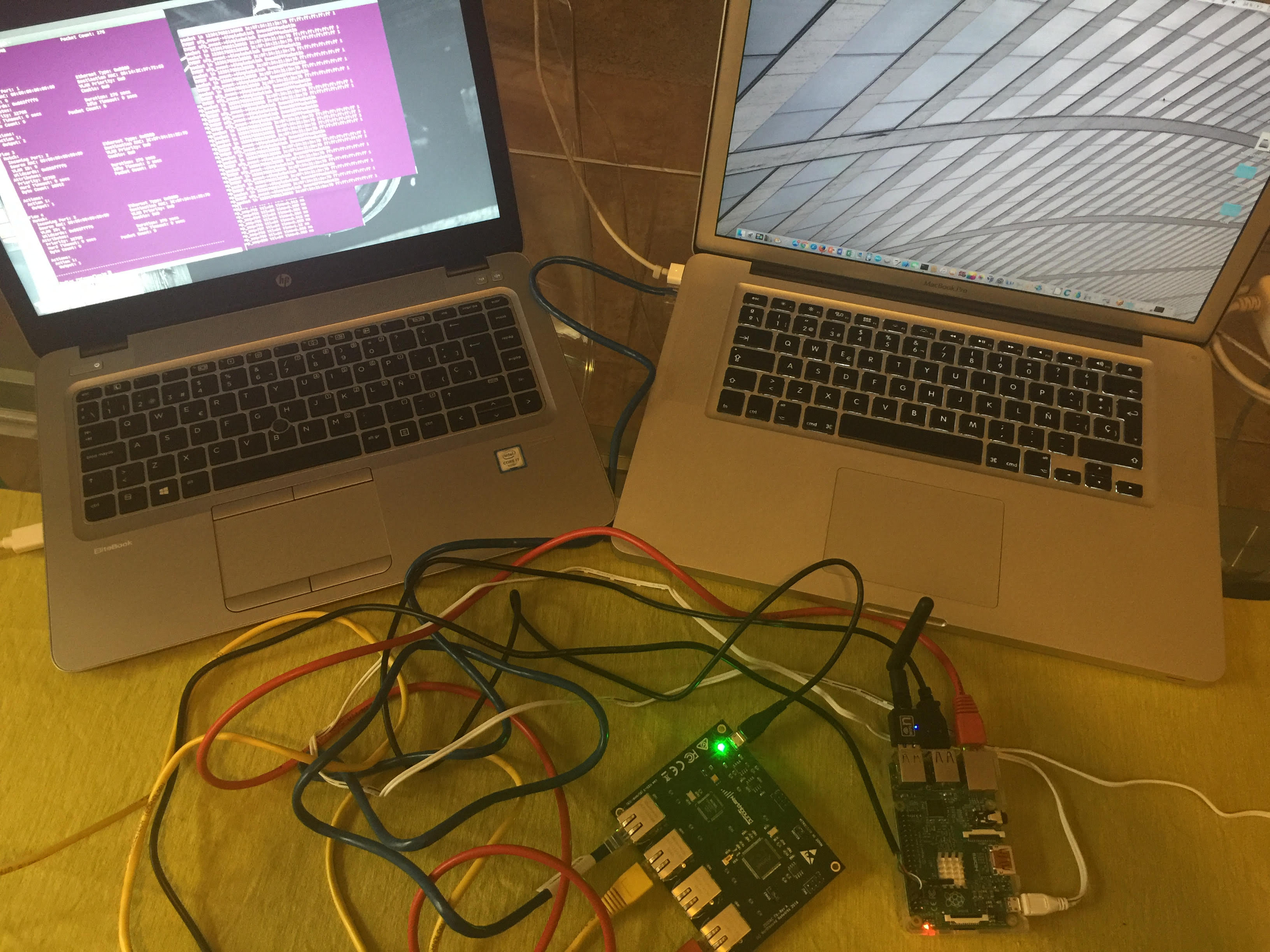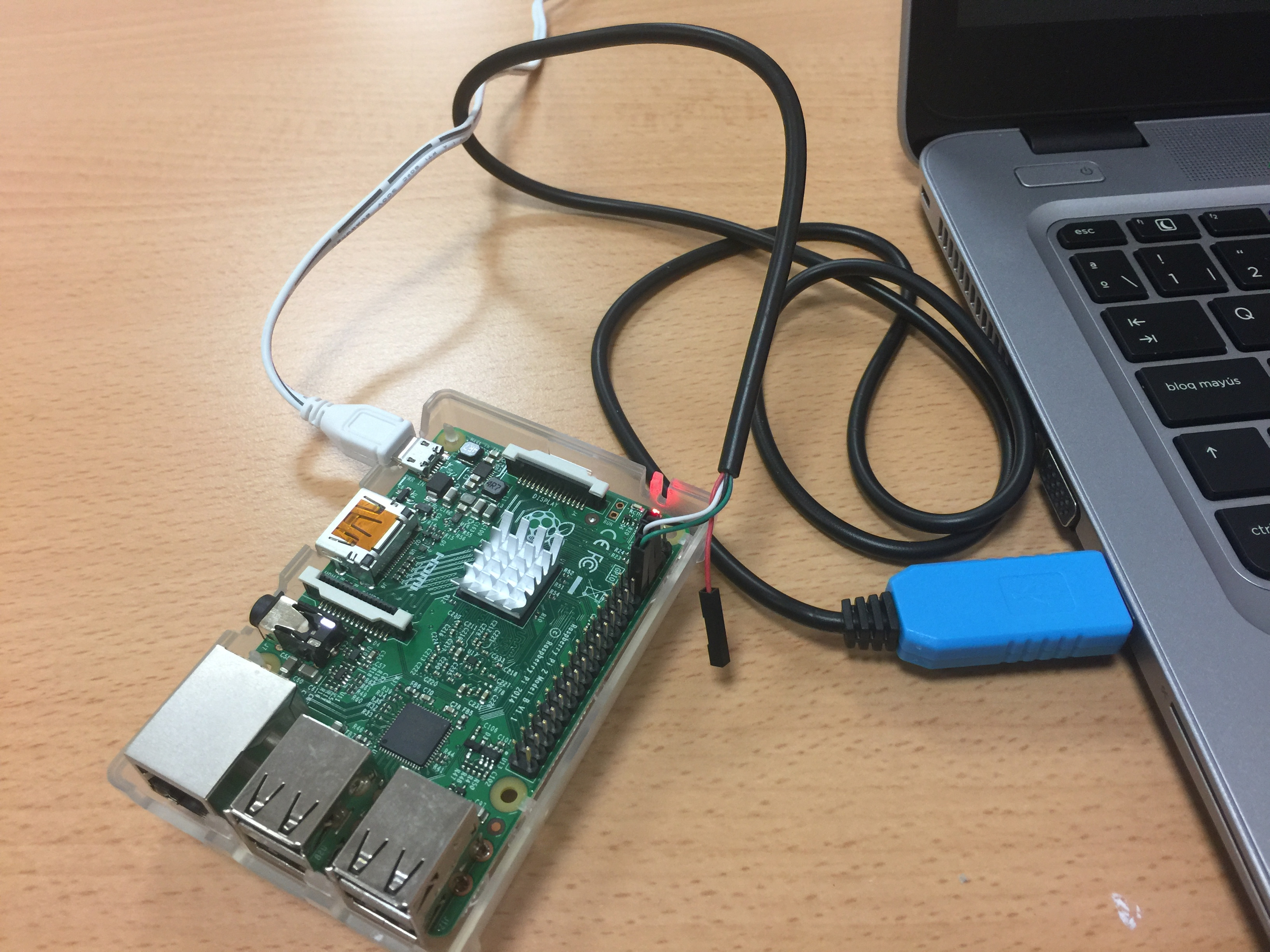ZodiacFX + Raspberry pi
En este tutorial se encuentra la documentación que he utilizado para poner en marcha el switch openFlow Zodiac FX controlado desde la raspberryPi.

Preparando la raspberry pi
Desde Linux, introducir miniSD en el lector de tarjetas y ver cuál es el dispositivo correspondiente a miniSD:
$ df -h
Este comando mostrará todas las particiones, hay que localizar la que se corresponde con la memoria miniSD. En particular, en Linux será algo como: /dev/sdX1 montada en /media/nombreUsuario. Por ejemplo, en mi caso: /dev/sdd1.
Si la memoria miniSD tenía grabada otra distribución puede que tenga asociadas varias particiones: /dev/sdX1, /dev/sdX2, etc. En mi caso ya tenía grabada otra distribución Linux, por eso en mi caso se mostraban: /dev/sdd1 y /dev/sdd2. Es necesario desmontar estas particiones antes de grabar. En mi caso:
$ umount /dev/sdd1
$ umount /dev/sdd2
Comprobar que ya no están montadas:
$ df -h
Descargar la imagen de raspian. Yo he probado con raspbian Jessi with pixel (release 2017-04-10).
Grabar la imagen en el dispositivo que hemos detectado como miniSD: /dev/sdX (sin el número):
$ sudo dd bs=4M if=2017-04-10-raspbian-jessie.img of=/dev/sdX
Montar el sistema de ficheros de raspbian para asignar una configuración inicial IP, es necesario modificar el fichero /media/miNombreUsuario/etc/network/interfaces. Vamos a asignar a la raspberry la dirección 10.0.1.8 en la red 10.0.1.0/24, teniendo como gateway la dirección IP 10.0.1.99 que es la que tiene asignada por defecto el switch Zodiac FX.
auto eth0
iface eth0 inet static
address 10.0.1.8
netmask 255.255.255.0
Para probar la raspberry, insertamos la tarjeta miniSD en la rapsberry pi y enchufamos el cable de alimentación. A continuación conectamos el switch Zodiac FZ a un puerto USB de la raspberry pi con el cable de alimentación que trae el switch.
Controlar la raspberry pi
El acceso a la raspberry se puede hacer de varias formas:
Con una pantalla, teclado y ratón para poder conectarlos a la raspberry.
Con un adaptador wifi para el puerto usb de la raspberry. Puedes configurarlo siguiendo estas instrucciones.
Con un cable TTL serial USB.

Conectamos el cable a la los pines según las instrucciones y conector USB a una máquina. Desde la máquina usamos el comando:
$ sudo screen /dev/ttyUSB0 115200De esta forma tendremos una consola de la raspberry pi a través del puerto serie. Los datos de usuario por defecto en raspbian son:
usuario: pi contraseña: raspberry
Comunicación entre raspberry y ZodiacFX
Si se ha instalado wifi en la raspberry pi se puede mantener el cableado como está para descargar paquetes en la raspberry pi. Si no, habrá que conectar el cable de red a un router/switch que permita la conexión de la raspberry pi a Internet (ya sea po DHCP o con una dirección IP fija). Una vez que tenemos conectividad al exterior desde la raspberry pi instalaremos el paquete:
pi@raspberrypi:~$ sudo apt-get install minicom
Este paquete permitirá conectarnos al switch desde la raspberry pi a través del dispositvo ttyACM0.
- Conectar un cable de red de la raspberry pi al puerto 4 del switch
- Conectar el cable USB de Zodiac FX a la raspberry pi para alimentar el switch.
Para verificar la comunicación entre raspberry y switch, desde una consola de la raspberry ejecutar:
pi@raspberrypi:~$ ping 10.0.1.99
Para abrir un terminar con el switch:
pi@raspberrypi:~$ minicom --device /dev/ttyACM0
Zodiac_FX# config
Zodiac_FX(config)# show config
--------------------------------------------------------------------
Configuration
Name: Zodiac_FX
MAC Address: 70:B3:D5:6C:D7:4C
IP Address: 10.0.1.99
Netmask: 255.255.255.0
Gateway: 10.0.1.1
OpenFlow Controller: 10.0.1.8
OpenFlow Port: 6633
Openflow Status: Enabled
Failstate: Secure
Force OpenFlow version: Disabled
Stacking Select: MASTER
Stacking Select: Disabled
EtherType Filtering: Disabled
-------------------------------------------------------------------
Zodiac_FX(config)# exit
Ejecutar el comando que visualiza los puertos en el switch, sólo hay un cable conectado en el puerto 4, por eso sólo se muestra ese puerto UP. Observa que por defecto los puertos 1 a 3 se encuentra en la VLAN 100 y el puerto 4 en la VLAN 200:
Zodiac_FX# show ports
-------------------------------------------------------------------------
Port 1
Status: DOWN
VLAN type: OpenFlow
VLAN ID: 100
Port 2
Status: DOWN
VLAN type: OpenFlow
VLAN ID: 100
Port 3
Status: DOWN
VLAN type: OpenFlow
VLAN ID: 100
Port 4
Status: UP
VLAN type: Native
VLAN ID: 200
-------------------------------------------------------------------------
Ejecutar el comando que muestra el estado del switch
Zodiac_FX# show status
-------------------------------------------------------------------------
Device Status
CPU UID: 1396060416-1313362771-858796593-892416053
Firmware Version: 0.72
CPU Temp: 30 C
Uptime: 00:08:05
-------------------------------------------------------------------------
Mostrar el estado de openFlow:
Zodiac_FX# openflow
Zodiac_FX(openflow)# show status
-------------------------------------------------------------------------
Status: Disconnected
-------------------------------------------------------------------------
Ejecutar el comando que muestra los flujos openFlow:
Zodiac_FX(openflow)# show flows
No Flows installed!
Instalación de controlador ryu en la raspberry pi
Para instalar el controlador ryu en la raspberry pi es necesario que ésta tenga acceso a Internet:
pi@raspberrypi:~$ sudo apt-get update
pi@raspberrypi:~$ sudo apt-get install python-routes python-webob
pi@raspberrypi:~$ sudo apt-get install python-paramiko python-yaml libpython-dev
pi@raspberrypi:~$ sudo pip install tinyrpc
pi@raspberrypi:~$ sudo pip install ovs
pi@raspberrypi:~$ sudo pip install eventlet==0.19.0
pi@raspberrypi:~$ sudo pip install ipaddr
pi@raspberrypi:~$ sudo pip install six
pi@raspberrypi:~$ git clone git://github.com/osrg/ryu.git
pi@raspberrypi:~$ cd ryu
pi@raspberrypi:~$ sudo python ./setup.py install
pi@raspberrypi:~$ sudo pip install oslo.config
pi@raspberrypi:~$ sudo pip install --upgrade oslo.config
pi@raspberrypi:~$ sudo pip install msgpack-python
Para verificar la instalación de ryu:
pi@raspberrypi:~$ ryu-manager --version
Para iniciar el controlador:
pi@raspberrypi:~$ ryu-manager --verbose ryu/ryu/app/simple_switch.py
Si se conectan dos máquinas (con direcciones IP dentro de la subred 10.0.1.0/24) en los puertos 1 a 3 del switch se puede observar cómo hay conectividad entre ellos.
Instalación de controlador faucet-ryu en la raspberry pi
Para instalar el controlador faucet en la raspberry pi es necesario que ésta tenga acceso a Internet:
sudo apt-get install git minicom libpython-dev python-yaml paramiko
sudo pip install ipaddr
sudo pip install --upgrade six
sudo pip install ryu
git clone https://github.com/REANNZ/faucet
La versión de ryu-manager debería ser 4.14:
pi@raspberry:~$ ryu-manager --version
ryu-manager 4.14
Hay que identificar la carpeta donde se ha instalado Faucet, es decir, donde se encuentra el fichero faucet.py, en nuestro caso es: /home/pi/faucet/faucet/faucet.py. Por tanto, se instalado en /home/pi/faucet/faucet.
Si ZodiacFX's MAC es 70:B3:D5:6C:D7:4C el DPID 0x70b3d56cd74c (todos los dígitos juntos borrando ":" y anteponiendo 0x).
La configuración de faucet y los ficheros de log se pueden dejar en una carpeta, por ejemplo ~/zodiacfx. Crearemos esa carpeta.
La configuración se realiza a través de archivos YAML (YAML Ain't Markup Language). Para ello, hay que crear el fichero faucet.yaml dentro de la carpeta ~/zodiacfx con el siguiente contenido, teniendo en cuenta que dp_id debe ser el identificador del switch:
vlans:
100:
name: "dev VLAN-100"
dps:
zodiac-fx-1:
dp_id: 0x70b3d56cd0c0
hardware: "ZodiacFX"
interfaces:
1:
native_vlan: 100
2:
native_vlan: 100
3:
native_vlan: 100
El contenido del fichero anterior tiene 2 partes:
- Definición de VLANS (
vlans) cuyo identificador de vlan (100) queda asociado a su nombredev VLAN-100. - Deficición de Datapath (
dps) que usa un identificador interno como clavezodiac-fx-1y cuyo identificador esdp_id(64 bits en hexadecimal). A continuación se han definido las interfaces de 1 a 3, en modonative_vlan: 100. Esto significa que cualquier tráfico recibido en dichas interfaces se etiquetará con VLAN=100 y cualquier tráfico enviado a través de estas interfaces deberá eliminarse su etiqueta VLAN=100. Las máquinas conectadas a estos puertos estarán utilizando la VLAN=100 sin necesidad de que dichas máquinas tengan configuración específica de esa VLAN. Otro tipo de configuración de interfacestagged_vlanspermite que la interfaz pueda recibir/enviar tráfico que ya viene etiquetado con determinadas VLANs, por ejemplo:tagged_vlans: [10, 20].
A continuación exportamos las variables de entorno, donde se encuentran los ficheros de configuración y arrancamos Faucet. Podemos escribir un scrip de arranque, por ejemplo con el nombre startFaucet.sh:
#!/bin/bash
export FAUCET_CONFIG=~/zodiacfx/faucet.yaml
export FAUCET_LOG=~/zodiacfx/faucet.log
export FAUCET_EXCEPTION_LOG=~/zodiacfx/faucet_exception.log
export FAUCET_APP_DIR=/home/pi/faucet/faucet
export FAUCET_LISTEN_PORT=6633
export FAUCET_LISTEN_HOST=10.0.1.8
sudo ryu-manager --ofp-listen-host=$FAUCET_LISTEN_HOST --ofp-tcp-listen-port=$FAUCET_LISTEN_PORT $FAUCET_APP_DIR/faucet.py --verbose
Para arrancar faucet:
pi@raspberry:~$ ./startFaucet.sh
lzma module is not available
Registered VCS backend: git
Registered VCS backend: hg
Registered VCS backend: svn
Registered VCS backend: bzr
loading app faucet.faucet
Generating grammar tables from /usr/lib/python2.7/lib2to3/Grammar.txt
Generating grammar tables from /usr/lib/python2.7/lib2to3/PatternGrammar.txt
Create CustomEvent called
loading app ryu.controller.ofp_handler
instantiating app None of DPSet
creating context dpset
creating context faucet_api
instantiating app faucet.faucet of Faucet
instantiating app ryu.controller.ofp_handler of OFPHandler
BRICK dpset
PROVIDES EventDPReconnected TO {'Faucet': set(['dpset'])}
PROVIDES EventDP TO {'Faucet': set(['dpset'])}
CONSUMES EventOFPStateChange
CONSUMES EventOFPPortStatus
CONSUMES EventOFPSwitchFeatures
BRICK Faucet
CONSUMES EventDPReconnected
CONSUMES EventFaucetHostExpire
CONSUMES EventDP
CONSUMES EventFaucetReconfigure
CONSUMES EventFaucetResolveGateways
CONSUMES EventOFPErrorMsg
CONSUMES EventOFPPacketIn
CONSUMES EventOFPPortStatus
CONSUMES EventOFPSwitchFeatures
CONSUMES EventFaucetAdvertise
CONSUMES EventFaucetMetricUpdate
BRICK ofp_event
PROVIDES EventOFPStateChange TO {'dpset': set(['main', 'dead'])}
PROVIDES EventOFPErrorMsg TO {'Faucet': set(['main'])}
PROVIDES EventOFPPacketIn TO {'Faucet': set(['main'])}
PROVIDES EventOFPPortStatus TO {'dpset': set(['main']), 'Faucet': set(['main'])}
PROVIDES EventOFPSwitchFeatures TO {'dpset': set(['config']), 'Faucet': set(['config'])}
CONSUMES EventOFPEchoReply
CONSUMES EventOFPHello
CONSUMES EventOFPErrorMsg
CONSUMES EventOFPEchoRequest
CONSUMES EventOFPPortStatus
CONSUMES EventOFPSwitchFeatures
CONSUMES EventOFPPortDescStatsReply
EVENT Faucet->Faucet EventFaucetResolveGateways
EVENT Faucet->Faucet EventFaucetHostExpire
EVENT Faucet->Faucet EventFaucetMetricUpdate
EVENT Faucet->Faucet EventFaucetAdvertise
connected socket:<eventlet.greenio.base.GreenSocket object at 0x7461a430> address:('10.0.1.99', 51509)
hello ev <ryu.controller.ofp_event.EventOFPHello object at 0x7462c890>
move onto config mode
EVENT ofp_event->dpset EventOFPSwitchFeatures
EVENT ofp_event->Faucet EventOFPSwitchFeatures
switch features ev version=0x4,msg_type=0x6,msg_len=0x20,xid=0xe9121eb4L,OFPSwitchFeatures(auxiliary_id=0,capabilities=7,datapath_id=123917682136908L,n_buffers=0,n_tables=10)
move onto main mode
EVENT ofp_event->dpset EventOFPStateChange
DPSET: register datapath <ryu.controller.controller.Datapath object at 0x7462c4b0>
EVENT dpset->Faucet EventDP
EVENT Faucet->Faucet EventFaucetResolveGateways
EVENT Faucet->Faucet EventFaucetResolveGateways
EVENT Faucet->Faucet EventFaucetMetricUpdate
EVENT Faucet->Faucet EventFaucetHostExpire
EVENT Faucet->Faucet EventFaucetAdvertise
EVENT Faucet->Faucet EventFaucetResolveGateways
EVENT Faucet->Faucet EventFaucetResolveGateways
EVENT Faucet->Faucet EventFaucetHostExpire
EVENT Faucet->Faucet EventFaucetAdvertise
EVENT Faucet->Faucet EventFaucetMetricUpdate
EVENT Faucet->Faucet EventFaucetResolveGateways
EVENT Faucet->Faucet EventFaucetResolveGateways
EVENT Faucet->Faucet EventFaucetHostExpire
EVENT Faucet->Faucet EventFaucetAdvertise
Inicialmente la configuuración del switch indica que está conectado al controlador:
Zodiac_FX# openflow
Zodiac_FX(openflow)# show status
-------------------------------------------------------------------------
Status: Connected
Version: 1.3 (0x04)
No tables: 8
No flows: 36
Total Lookups: 0
Total Matches: 0
------------------------------------------------------